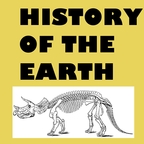
History of the Earth
Summary: 366 snapshots of earth history in the form of a perpetual calendar, with daily episodes for 2014 and weekly thereafter. Find all the posts at http://historyoftheearthcalendar.blogspot.com
- Visit Website
- RSS
- Artist: Richard I. Gibson
- Copyright: Copyright Richard I. Gibson
Podcasts:
By Richard I. Gibson Here’s the podcast: Transcript: It seems like only a few days ago that we were talking about the break-up of the supercontinent called Columbia. Now we’re assembling another one, called Rodinia. Well, yes – but in those few days, 400 million years have passed since the Belt Basin began to form on January 24, 1.4 billion years ago. 400 million years is enough time for continents to rift apart and come back together. They were coming together again about 1 billion years ago. Map from US Antarctic Program (public domain). Red dots are granite bodies.Rodinia is a Russian word meaning the motherland. It’s fair to think of Rodinia as a more or less conglomeration of continental masses, but it’s probably wrong to visualize a concerted assembly followed by a synchronized separation. Just as today, there were probably some pieces coming together while others were drifting apart. But Rodinia does represent a large landmass that contained at least a good number of the continental blocks, for maybe as much as 200 million years. We really don’t know the details of Rodinia’s configuration all that well. The map in the blog shows one version, but there are plenty of alternatives. While it was one big land mass, it might have served as an insulating blanket over the hot interior of the earth, so that granites pooled along the base of the continental crust and intruded it in places – at least, there are a lot of granite bodies of this age that don’t seem to be related to mountain building. They might represent something like that. However it was assembled, it began to break apart by about 750 million years ago, and maybe as early as 800 million years ago. The break up of Rodinia may have impacted both the climate and the evolution of life on earth. We’ll discuss those impacts in a few days as the Proterozoic comes to an end. On January 28, 1902, William C. Krumbein was born in Beaver Falls, Pennsylvania. He was an innovative geologist, and co-author of the traditional textbook on sedimentation and stratigraphy that was used in many college courses from the 1960s to the 1980s. Further reading: http://en.wikipedia.org/wiki/Rodinia http://io9.com/5744636/a-geological-history-of-supercontinents-on-planet-earth http://www.peripatus.gen.nz/paleontology/Rodinia.html